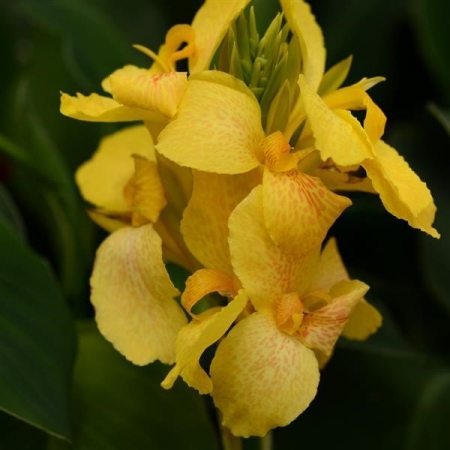Canna (Canna)
×
Color Name: Cannova Yellow
Shades of cream, pastel yellow and lemon brushed with a few salmon speckles all on one bloom, making a real statement in the garden. Cannas love sun and require a minimum of four hours of direct sunlight. Ideal for mass plantings, bedded areas or containers.
Cannas are tropical and subtropical flowering plants with large, banana-like leaves. They can be grown as annuals in cooler regions. Cannas will instantly add a touch of the tropics to any landscape. A surge in interest and hybridizing has resulted in a dazzling array of many bold, colorful cannas to choose from.
Growing Tips: Cannas may be planted in the spring after danger from frost. Best results are achieved when planted in a loose, fertile and well-draining soil that has warmed to at least 60 degrees. Cannas will tolerate a wide range of growing conditions. They love sun and require a minimum of four hours of direct sunlight. Cannas should be watered thoroughly once a week by slowly soaking the area around roots.
When planting in containers, hanging baskets and window boxes, we recommend using our potting soil which is specially formulated for our plants. An application of a time release fertilizer at the time of planting will help to ensure the best possible performance. Zehr's Osmocote blend is perfect for the job. We also suggest fertilizing every two weeks during the hot summer months of June, July and August with Maxsea, which you can purchase at Zehr's. Begonias, Impatiens and most plants grown for foliage normally do not need as much fertilizer.
Photo courtesy of Ball Horticultural Company.
Shades of cream, pastel yellow and lemon brushed with a few salmon speckles all on one bloom, making a real statement in the garden. Cannas love sun and require a minimum of four hours of direct sunlight. Ideal for mass plantings, bedded areas or containers.
Cannas are tropical and subtropical flowering plants with large, banana-like leaves. They can be grown as annuals in cooler regions. Cannas will instantly add a touch of the tropics to any landscape. A surge in interest and hybridizing has resulted in a dazzling array of many bold, colorful cannas to choose from.
Growing Tips: Cannas may be planted in the spring after danger from frost. Best results are achieved when planted in a loose, fertile and well-draining soil that has warmed to at least 60 degrees. Cannas will tolerate a wide range of growing conditions. They love sun and require a minimum of four hours of direct sunlight. Cannas should be watered thoroughly once a week by slowly soaking the area around roots.
When planting in containers, hanging baskets and window boxes, we recommend using our potting soil which is specially formulated for our plants. An application of a time release fertilizer at the time of planting will help to ensure the best possible performance. Zehr's Osmocote blend is perfect for the job. We also suggest fertilizing every two weeks during the hot summer months of June, July and August with Maxsea, which you can purchase at Zehr's. Begonias, Impatiens and most plants grown for foliage normally do not need as much fertilizer.
Photo courtesy of Ball Horticultural Company.
|
Flower Color: Yellow Shades Foliage Color: Green Shades
Height: 24 to 36 Inches Spread: 12 to 24 Inches Hardy in Zone: 7 |
Blooms: Summer to Fall
Foliage Season: All Season |
Growth Rate |
Medium
|
Attributes |
Extended Bloomer Container Specimen Plant Mass Planting Landscapes Easy to Grow Drought Tolerant Cut Flower or Foilage Border
|








